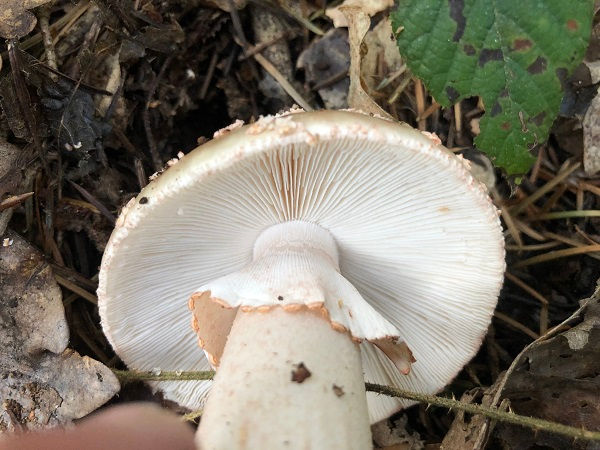
Edible mushroom - advanced identification Season - summer to autumn Common names Blusher, the blusher, blusher mushroom
Scientific name meaning: Amanita originates from the Greek Amanitai, which is though to mean of the Amanus: a range of mountains in Turkey. Rubescens is Latin and means to become red, a reference to the red bruising this mushroom exhibits
Habitat  The blusher is mycorrhizal and grows in association with deciduous and coniferous trees, including oak, beech, fir, pine and hornbeam, and often favouring slightly acidic poor soil. |
Overall structure and growth  The blusher begins forming in a spherical egg-like sack called a volva/universal veil. It develops into a tidy mushroom with a domed cap that flattens and sometimes funnels up with age. It can be found growing individual but is more usually found in groups. |
Cap  The caps colour can range from pale tan colour to dark brown. It can reach between 5cm and 20cm, is domed at first and eventually flattens out and slightly funnels up. Grey or dirty-white fragments of the universal veil/volva remain on the cap, though these can be washed away in heavy rain. The cap will bruise pink when damaged. |
Gills and spores  The white gills are crowded and adnate to free. Older specimens may have red or pink speckles. When damaged, the gills bruise pink. The spore colour is white. |
Stem  Sturdy and white or dirty white in colour, the stem can reach 7 to 15cm tall, and is 1-3cm wide. It has a stem ring, or skirt, that has striations on the upper surface. Where the stem has been damaged, the flesh will bruise pink. In older specimens, the stem is often hollow. Only very young specimens have visible volval remains at the stem base more often it appears swollen. |
Flesh, smell and taste  The flesh is white bruising pink when damaged. The smell and taste are not distinct. As this is an Amanita, tasting should only be attempted by more experienced foragers/mycologists. |
Possible lookalikes  Could be confused with the poisonous panther cap (Amanita pantherina), pictured, but the veil remnants are white, it doesn't not bruise pink and does not have striations on the skirt/ring. Also, the grey spotted Amanita (Amanita excelsa var spissa and Amanita excelsa var excelsa) but this does not bruise pink. |
Use as food Must be thoroughly cooked as it contains a haemolytic toxin in its raw state Hazards Poisonous if uncooked or undercooked
Use in herbal medicine and medicine none known
If you are suffering from any ailment or need medical advice, please see your General Practitioner Other uses None known Importance to other species Provides food for a the larvae of a number of fly species
Always stay safe when foraging. You need to be 100% sure of your identification, 100% sure that your foraged item is edible, and 100% sure that you are not allergic to it (it is good practice to always try a small amount of any new food you are consuming). If in doubt, leave it out!

Comments